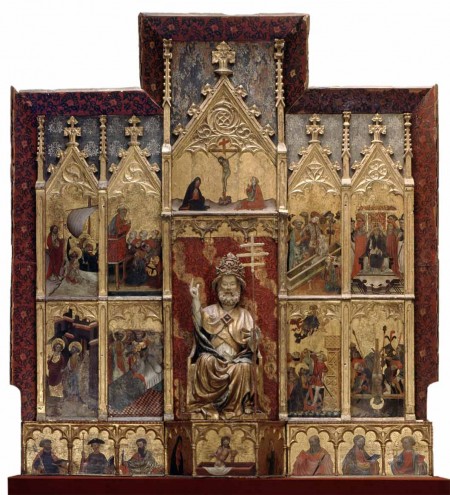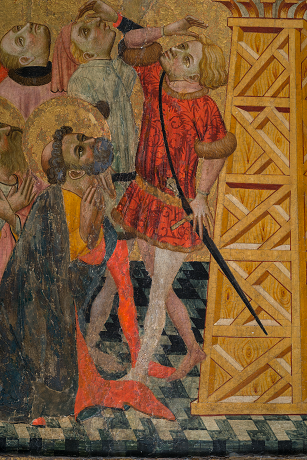The large panels of wood had been joined and the soft pine coated with a mixture of animal skin glue and resin. The painter would have preferred to use a wood with a finer grain for this retablo, or altarpiece, an oak or linden, but no such material was available in this area of Spain. The cloth, which would help support the ground for the painting, was stretched over the wet size. It was another very hot day in the workshop, like so many in Saragossa. Once the size dried, layer after layer of gesso would be applied over the cloth. Each layer would be finely sanded before the next was applied. The tedious application would go slowly until finally, a smooth hard surface was created and ready for the artist’s brush.
Scenes from the life of St. Peter would be depicted. Jesus inviting the fisherman to put down his net and follow, Peter preaching at Pentecost and escaping prison with the aid of an angel. The final scene would reveal the saint’s martyrdom and his request to be crucified head down, feeling unworthy to suffer in the same manner as Jesus. The saint’s life would be a most relevant subject, as parts of Spain were referred to as the “land of St. Peter” during the earlier Crusades. All of these images would be rendered in the current style, with brilliantly colored figures in sumptuous costume surrounded by glittering gold detail. Little did the artist know that more than 600 years later, the retablo created in his workshop would undergo very careful steps to restore its original beauty and be viewed by admirers across great time and distance.
The Retablo of St. Peter currently has a clouded history. Attributed to the Spanish artist Leonardo Zaragoza, we know little about its 600 year journey from Northern Spain to the American Midwest and Cincinnati, OH. We do not know for whom, or for what location, church or monastery, this retablo was originally created. The histories of a few such works from this period are well documented. The Ghent Altarpiece by Jan van Eyck and the altarpiece of Ciudad Roderigo by Fernando Gallego, suffered natural disaster, dismantling, theft, storage in bunkers and other mishaps with records or witnesses tracing the works’ journeys. The Retablo of St. Peter has no such trail. In the 2008 publication, Retablos, Prestigio y Dinero: Talleres y Mercado de pintura en la Valencia del gotico internacional, the author quotes Pedro IV, King of Aragon as extolling, “Lorenc Caragoca, lo millor pintor que en esta ciutat sia” or “Lorenzo Zaragoza, the best painter in either city”. She then goes on to reference a piece created for the king, “en 1389 un retablo del san Pedro Apostal”, but there is no direct connection that can be made between these references and the piece currently being readied for restoration at the Cincinnati Art Museum. Of the altar panel pieces created during the time of the International Gothic Style, between 1350 and 1450 approximately, it has been estimated that 99% have been lost, which makes this particular work in the museum’s collection, a marvelous example of the period and style, a significant object to protect.
When Serena Urry arrived at the Cincinnati Art Museum in 2012 to begin her responsibility as Chief Conservator, the Retablo of St. Peter was in storage. The eighteen panels from the altar piece had last been displayed in the museum in 2010. Purchased by the museum in 1960, from a private dealer in Barcelona, the museum at that time was actively expanding its collection of Spanish works. I had the opportunity to speak with Ms. Urry about the public restoration of this exceptional piece and get a very close look at the existing panels that would be subject to her careful observation and skill.
I was curious about her goals as the Chief Conservator on this particular project. Initially, she explained that this altarpiece, has, in conservator jargon, “inherent vice”, a condition that is part of the work that cannot be changed. It is a painting that has been created on a soft wood, a pine that was a fast growing species available in the warm climate of northern Spain. Nothing can be done to remedy this fact. There is evidence of insect damage and movement in the panels. Changes in humidity over time can greatly affect the movement and shape of wood panels. This is something that can be more carefully controlled in a museum environment today.
While on view in the museum’s gallery, across from the Terrace Café, over the three month period, Urry’s focus will be on cleaning the altarpiece. The largest challenge to be addressed is the removal of layers of a synthetic wax that were applied to the front of the retablo. She believes that this was done some time in the first half of the 20th century in order to contain the flaking and loss of paint from the surface of the wood. This treatment didn’t fix the problem of paint and gold separating from the surface; it simply covered it and held it in place. The wax also interfered with the introduction of any type of adhesives. In addition, the films of wax trapped dirt, so the piece now has a cloudy and dull appearance, coupled with a clouded history. Areas of punching, small patterned depressions made in the wood and treated with gold, are now filled with wax and debris and no longer glitter.
While looking at the altarpiece in the conservation lab it was clear that this was going to be a daunting project. Because of her lengthy experience working as a conservator, previously at the Barnes Foundation in Philadelphia and the Detroit Institute of Arts, Ms. Urry felt that technically, the work to be done was not a concern, but the volume of work, cleaning all eighteen panels, was challenging. It was suggested by Urry that the original retablo may have included additional panels, which was one of the other many unknowns about this work.
I was curious about how all this wax would be removed. Solvents proved to present problems with the wax, so a chemical solution was not preferable. In speaking with a fellow conservator, Urry decided that a mechanical method was best. She would heat the wax with a hot air gun and carefully remove it one small area at a time. Her efforts will require working at a microscopic level. She had already begun this process on a few areas of the panels in the lab. The difference was remarkable. With the wax removed, the color beneath was brilliant again and the gold shone and sparkled. Unfortunately, when removing the wax, the pigment and gold being held in place also comes away. Urry warned that the altarpiece will not be very attractive during this cleaning phase.
It is important that she can see and work on all the panels together throughout the restoration, particularly after the cleaning, when in painting needs to be done, to make certain that there is visual consistency from one panel to another. During the exhibit, all the panels will be on view, just as they are in the conservation lab. Urry initially proposed the public viewing of this process, “hoping that our visitors will be inspired to return to the museum over the course of the exhibit, to watch as the paintings are revealed by cleaning.” And that is simply the beginning. Once the cleaning is complete, all the losses, areas where loose pigment has been removed, will be filled with new ground. Then in painting will need to be done in these areas. Again, she will be treating all the panels simultaneously. Finally, the entire piece will be revarnished. Urry’s goal throughout this restoration will be to remove what is failing and put less material back. Although the public will have the opportunity to view the cleaning of the retablo during this three month exhibit, Urry expects the entire project to take several years. Once her work is complete she feels the retablo will be stable for the next 50 to 100 years.
Conservation on View, will present wonderful opportunities from January through April. Chief Conservator Serena Urry will have time dedicated to restoring and revealing the original surfaces of this beautiful altarpiece and possibly illuminate some part of its dimly lit past. Visitors will have a chance to view the museum at its best, having the rare experience to observe the renewal of an exceptional object created 600 years ago.
Marta Hewett is the owner of the Marta Hewett Gallery, which has exhibited finely crafted contemporary art for over 25 years



